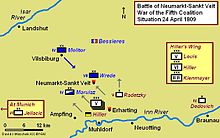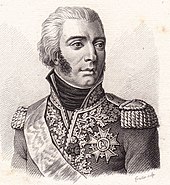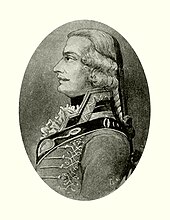Battle of Neumarkt-Sankt Veit
Sacile - Teugn-Hausen - Vistula campaign - Raszyn - Abensberg - Landshut - Eggmühl - Regensburg - Neumarkt - Ebelsberg - Piave - Aspern - Sankt Michael - Stralsund - Bergisel - Raab / Győr - Graz - Wagram - Korneuburg - Stockerau - Gefrees - Hollabrunn - Schöngrabern - Znojmo - Walcheren
The battle of Neumarkt-Sankt Veit was part of the Fifth Coalition War and took place on April 24, 1809. The French-Bavarian troops in pursuit under Marshal Bessières were attacked by a numerically superior Austrian force under Field Marshal Lieutenant Johann von Hiller . The place Neumarkt is located ten kilometers north of Mühldorf and 33 kilometers south of Landshut . Without knowing that the main Austrian army under Archduke Karl had already been defeated, Hiller's troops turned to the pursuers. South of Neumarkt-Sankt Veit, the French Molitor divisions and the Bavarian division von Wrede were attacked and thrown back to the north with a loss of around 2,000 men.
prehistory
The main Austrian army under Archduke Karl, which invaded Bavaria on April 10, was defeated by the French under Emperor Napoleon on April 20 at Abensberg and on April 22 at Eggmühl and split in two. The Austrian left wing under Hiller stayed on a 13-kilometer front between Mainburg in the south and Biburg in the north. Hiller's wing with 42,000 men consisted of the 5th Army Corps under Feldmarschalleutnant (FML) Archduke Ludwig of Austria , the VI. Army Corps under FML Hiller, as well as the II. Reserve Corps under FML von Kienmayer and parts of the III. Army Corps. After Abensberg the Austrian V. and VI. Army corps pushed to the southeast, Hiller's troops withdrew via Rottenburg to Pfeffenhausen . Hiller's losses between April 19 and 21 in the fighting near Abensberg and Landshut totaled 12,140 men and 11 artillery pieces. Hiller's forces shrank to 28,400 men with 70 cannons by the evening of April 22, due to the surrender of the FML von Lindenau division from the V Corps and the departure of Major General Schneller's cuirassier brigade .
Napoleon's main power began to pursue Archduke Karl to Bohemia , at the same time he gave Marshal Bessieres the instruction to pursue the Austrian left wing under Hiller and strengthened his cavalry division with two infantry divisions. Emperor Napoleon planned the Inn to cross and Braunau am Inn to conquer. He gave Bessières the instruction to take up the pursuit with the Bavarian Division von Wrede of the VII Corps, the French Division Molitor of the IV Corps and with the troops under Brigadier General Jacquinot . The following day Wredes division reached Neumarkt-Sankt Veit, from there the cavalry under Marulaz was sent ahead to the Inn. On April 23, the mass of Hiller's troops with 27,000 to 28,000 soldiers was near Mühldorf and Neuötting am Inn by noon . Because the division under FML Franz Jellacic was detached to Munich , the FML Dedovich brigade , which had previously secured security at Passau , came from the IV Army Corps under Hiller's command and was transferred to Braunau for security . Hiller noticed that the French persecution had subsided on the 23rd and decided to launch a counterattack. North of Mühldorf near Erharting, the French cavalry under Marulaz encountered Hiller's vanguard, whereupon he retreated towards Neumarkt on the evening of April 23rd.
The battle near Neumarkt
When Hiller learned that French troops had already reached Neumarkt, he decided to attack them. Marshal Bessieres, with the Molitor and Wrede divisions, along with the cavalry under Marulaz , had gathered about 18,000 men on both banks of the rather swampy Rott in front of and behind Neumarkt. The Bavarian division Wrede held in the front line. The French Molitor division was approaching from Vilsbiburg . The cavalry advanced as far as Unter-Rohrbach.
On April 24 at three in the morning, the Austrian troops crossed the Inn in Altötting and advanced it in three columns, each of which was preceded by its own avant-garde :
- 1st column under FML Fürst von Reuß-Plauen with the Brigades GM Bianchi and Colonel Fröhauf (10.5 battalions and 11 squadrons)
- 2nd column under FML Graf Kottulinsky with the brigades GM Weißenwolf (Klebeck Infantry Regiment No. 14 and Jordis Infantry Regiment No. 59) and GM Hohenfeld (12.5 battalions and 10 squadrons)
- III. Column under FML Vincent with the Brigade GM von Hoffmeister (Stipsics Hussars, Knesevich Dragoons, Benjowsky Infantry Regiment 31 and Splenyi Infantry Regiment 51 with 6 battalions and 9 squadrons) as well as the brigade of GM Nordmann in the avant-garde.
Reserves and wing protection
- Division of FML Schustekh with Brigade Major General Joseph von Mesko and Brigade Radetzky (8 battalions)
- II. Reserve Corps FML Baron von Kienmayer with the brigades GM d'Aspré and GM Clary (5 grenadier battalions and 4 squadrons)
- The independently operating brigade of Major General Reinwaldt has two battalions of the Joseph Mittrowski brigade and a squadron of Stipsics Hussars to demonstrate on the road leading to Eggenfelden to Unter-Turken.
Together with the three avant-gardes that were already on the other side of the Inn, as well as the reserve, the Joseph Mitrowsky regiment and the Rosenberg Chevaulegers , the Hillerian corps totaled 42 battalions and 39 squadrons.
According to Hiller's planning, three columns should be formed to counterattack at Winhering and march off from five o'clock in the morning with the center at Neumarkt, with the right wing at Kloster Sankt Veit, with the left wing at Nieder-Bergkirchen. The 1st column marched to the right of the road, leaving Erharting to the left and heading towards Klebing in order to advance to Leonberg . The second column began its march on the road via Erharting, and was instructed to proceed as far as Neumarkt, at the same height as the first. The III. The column took the path to the left of the road via Friering, Nieder-Porchkirchen towards the Rott section. FML Baron Vincent was supposed to facilitate the approach of Hiller's columns on Neumarkt by having his brigades attract the Bavarians' attention. General Nordmann commanded the vanguard of the III. Column and had the order of Degning to advance along the heights along the Inn valley to Mühldorf and then to support the operations of the center. Should the French offer longer resistance at Neumarkt, Nordmann's troops would have to deploy to bypass Lohkirchen and proceed against the right flank of the enemy. Securing on the right wing, Major General Radetzky's brigade advanced to Eggenfelden and led his brigade on the road to Landau via Gangkofen to Dingolfing . General Reinwaldt followed after Radetzky's troops marched from Wurmannsquick to Eggenfelden.
The second column of the Austrians had encountered the enemy at about 7 o'clock in the morning. General Mesko's brigade led the vanguard of the 2nd column on the main road via Neumarkt to Bina and clashed with the enemy beyond the village of Stetten. The Wrede and Molitor divisions had already moved from Landshut to Neumarkt. From there an advance guard was advanced, including two Bavarian battalions that occupied Erharting am Isen , and two cavalry regiments that advanced towards the Inn near Winhering . The 2nd Column could not fulfill the task prescribed by the disposition and could barely get an hour beyond Stetten, so Major General Weissenwolf had to be directed to the left against Lohkirchen .
Around 9 a.m. the battle raged across the board. The Bavarian division Wrede, which stood in front, had taken its line partly on the muddy banks between the city and its suburbs through the last parade and also had the flowing Rott at its back. Two mounted hunter regiments of General Marulaz had holed up near the village of Stetten. The Chevauxleger brigade under Colonel von Preysing stood behind Neumarkt along with the rest of the Bavarian infantry and had only sent a detachment to observe the Rott Valley in Hörbering . The control of the heights at Unterscherm and at the Sankt Veit monastery were the key to securing the positions on the right bank of the Rott. Only one regiment of Major General Minuzzi's Bavarian brigade was deployed there, and three Bavarian batteries were placed on advantageous points. The front of the Wrede division, which was well secured by overhanging positions, was quite extensive, and since there was no flank protection, it was easy to circumvent it, especially on the left wing.
The Austrian brigade of Major General Weissenwolf tried to develop on the heights of Lohkirchen and move skirmishers against the Rott, but on the whole to threaten the right flank of Bavaria. Soon the troops of the Hohenfeld Brigade, formed in 6 departments, also supported, so that the column of the FML Graf Kottulinsky received a new direction in which his troops should reach the Rott via Zangberg, where the 1st column was already in the fight. At 1 p.m. General Wrede's division found himself bypassed on both flanks and strongly pressed in the front, so that he had to retreat behind the Rott, where his troops were picked up by the Molitor division arriving from Vilsbiburg . The Bavarian Becker Brigade had to retreat from one height to the next, losing the village of Oberscherm and then getting into crisis-ridden disorder when the support of the Molitor division arrived at the right time. A French foot regiment strengthened the Bavarian left wing and tried to attack again when the Austrian Brigade Fröhauf appeared on the flank and rolled up the front from the left. As soon as Colonel Bakony (Infantry Regiment No. 39) noticed that the retreating French cavalry was faltering at the bridge over the Rott, he let his hunters attack this group. Together with parts of the Klebeck regiment, a mounted French hunter regiment that wanted to cover the retreat of the Bavarians was almost wiped out in a fight between the houses and gardens of the suburb. At around 3 p.m. the battle for the Austrians was decided. If Wrede had not extended his line-up before the parade at Unterscherm, Strass and Sankt Veit at the moment before the Austrian attack, so that he pulled most of his division to the right bank, he would have retreated over the narrow bridge of the Rott and through the sea of houses can be done in an orderly manner.
consequences
FML. Hiller lost 4 officers, 148 men, to wounded 21 officers and 603 men and 122 prisoners, a total of 776 dead and wounded, a total of 25 officers and 873 men. The Bavarians had 586 dead and wounded, plus 200 prisoners. The French loss of Bessieres was about 2000 men, of which 27 officers and 887 men were taken prisoner.
On the night of April 24th, Hiller learned of the defeat of Archduke Charles in the battle of Regensburg and withdrew to Neuötting . With further retreat on the Inn, the Hiller group reached Braunau and Burghausen on April 26th . At the same time, Massena's vanguard under Legrand moved into Schärding . The II. Reserve Corps under Kienmayer, belonging to the Hiller group, had already preceded the Linz area with around 4,500 infantry and 800 horsemen to secure the northern bank of the Danube. Napoleon moved his headquarters to Mühldorf on April 27 and to Burghausen on April 30, and instructed the IV Corps under General Masséna to take the road to Passau for the pursuit . Hiller tried in vain to counterattacks his division Schusteck to regain the lost line on the Inn, the brigade under Bianchi served in the north as flank cover on the road from Schärding to Wels and was advanced to Grieskirchen . When Hiller discovered that he was facing Napoleon's main army alone on the southern bank of the Danube , Hiller quickly withdrew to the east in the direction of Linz. He then had to break away from the pursuing French under Marshal Massena south of Linz over the Traun Bridge in the direction of Enns . The French were able to catch up with the Austrians on the Traun and on May 3rd the battle of Ebelsberg developed into a loss-making battle for the bridge and the town of Ebelsberg . The way to Vienna was then free for Napoleon I's troops .
literature
- Austrian military magazine, printed by Strauss Witwe and Sommer, Vienna 1846, p. 146 f.
- Friedrich Rudolf von Rothenburg: The weapons deeds of the Austrians in 1809 , Vienna 1838, p. 68 f.
- The 1809 campaign in Bavaria : Edited by the General Staff Section of the Royal Bavarian General Quartermaster Staff, Munich 1865, pp. 156-168
- Friedrich Heinrich von Stutterheim: The war of 1809 between Austria and France Volume 1, Verlag von Anton Strauss, Vienna 1822, pp. 323–331
- Friedrich von Hellwald : The 1809 campaign in Southern Germany, Volume 1, printed and commissioned by Carl Gerolds Sohn, Vienna 1864.





